#metrics
Text
100k views in under 24 hours

That's pretty big for us, not gonna lie.
Thanks to all those who've been spreading the word of the monke, we greatly appreciate all your support~
553 notes
·
View notes
Note
You've said before that modern games, even single player, will track player data. What sorts of things are actually logged? What do you think are some of the things players would least expect to be tracked?

We mostly track all the things that players choose to interact with. This means where they go, the things they spend time looking at, the NPCs they talk to, the things they buy, the recipes they craft, the menus they spend time in, the characters they romance, the gear they like to use, and so on and so forth. You know how achievements often require a bunch of very seemingly-arbitrary conditions to meet, like visiting Calendar Man at several major holidays in one of the Batman Arkham games? A good rule of thumb is that if we can check for it for an achievement, we're probably tracking it. We spend a huge amount of time and effort tracking all that information because we want to know what the players are spending their time doing in order to figure out what kind of new content we think they will like.

I think most players don't really understand how much tracking we do for UI/UX. We spend a lot of time and effort to track things like how many players don't continue beyond a certain point in order to figure out how we can make things smoother and easier for players to get to the fun bits. A huge amount of effort is spent tracking, analyzing, and interpreting data from the First Time User Experience (aka the FTUE), because we all want players to keep playing and not drop the game after the first few minutes.
[Join us on Discord] and/or [Support us on Patreon]
Got a burning question you want answered?
Short questions: Ask a Game Dev on Twitter
Long questions: Ask a Game Dev on Tumblr
Frequent Questions: The FAQ
76 notes
·
View notes
Text
seeing people wear dan and phil merch in public is kind of crazy like what do you mean you know these niche underground british youtubers who are you
#inspired by someone wearing back to the dead merch in public today#probs one of their best joint merch btw absolutely outsold legalise catboys#love how they made back to the dead like this is for ppl who are embarrassed to wear our merch in public#then made legalise catboys like the different audiences okayy#i have neither bc i’m povo#dan and phil#phan#metrics
37 notes
·
View notes
Photo

A request I filled on Stream - original character by Glacier Clear
Catch more like this @ twitch.com/sirtheartist
411 notes
·
View notes
Text
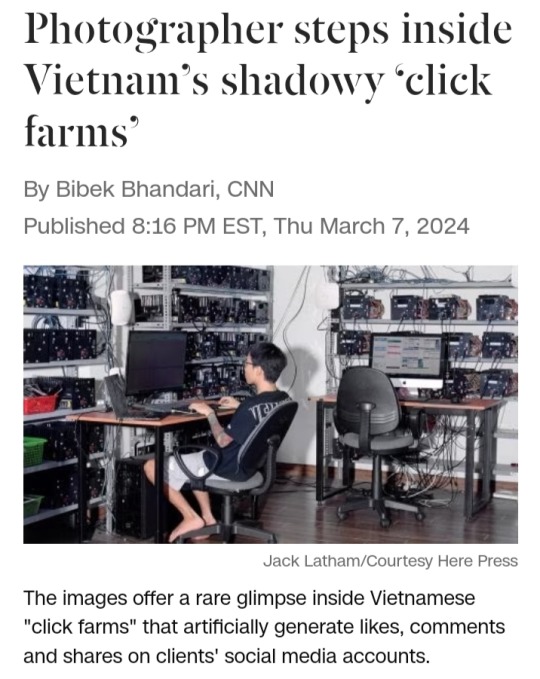
(CNN) — Jack Latham was on a mission to photograph farms in Vietnam — not the country’s sprawling plantations or rice terraces but its “click farms.”
Last year, the British photographer spent a month in the capital Hanoi documenting some of the shadowy enterprises that help clients artificially boost online traffic and social media engagement in the hope of manipulating algorithms and user perceptions.
The resulting images, which feature in his new book “Beggar’s Honey,” provide rare insight into the workshops that hire low-paid workers to cultivate likes, comments and shares for businesses and individuals globally.
“When most people are on social media, they want nothing but attention — they’re begging for it,” Latham said in a phone interview, explaining his book’s title.
“With social media, our attention is a product for advertisers and marketers.”
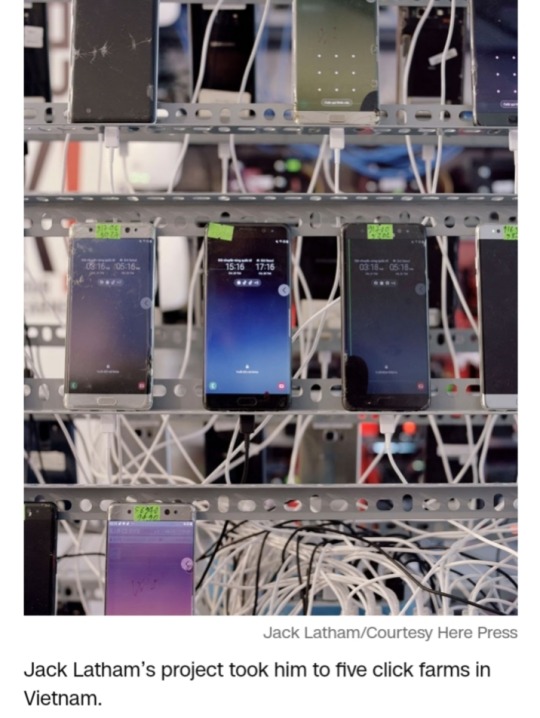
In the 2000s, the growing popularity of social media sites — including Facebook and Twitter, now called X — created a new market for well-curated digital profiles, with companies and brands vying to maximize visibility and influence.
Though it is unclear when click farms began proliferating, tech experts warned about “virtual gang masters” operating them from low-income countries as early as 2007.
In the following decades, click farms exploded in number — particularly in Asia, where they can be found across India, Bangladesh, Indonesia, the Philippines, and beyond.
Regulations have often failed to keep pace: While some countries, like China, have attempted to crack down on operations (the China Advertising Association banned the use of click farms for commercial gain in 2020), they continue to flourish around the continent, especially in places where low labor and electricity costs make it affordable to power hundreds of devices simultaneously.
‘Like Silicon Valley startups’
Latham’s project took him to five click farms in Vietnam.
(The click farmers he hoped to photograph in Hong Kong “got cold feet,” he said, and pandemic-related travel restrictions dashed his plans to document the practice in mainland China).
On the outskirts of Hanoi, Latham visited workshops operating from residential properties and hotels.
Some had a traditional setup with hundreds of manually operated phones, while others used a newer, compact method called “box farming” — a phrase used by the click farmers Latham visited — where several phones, without screens and batteries, are wired together and linked to a computer interface.
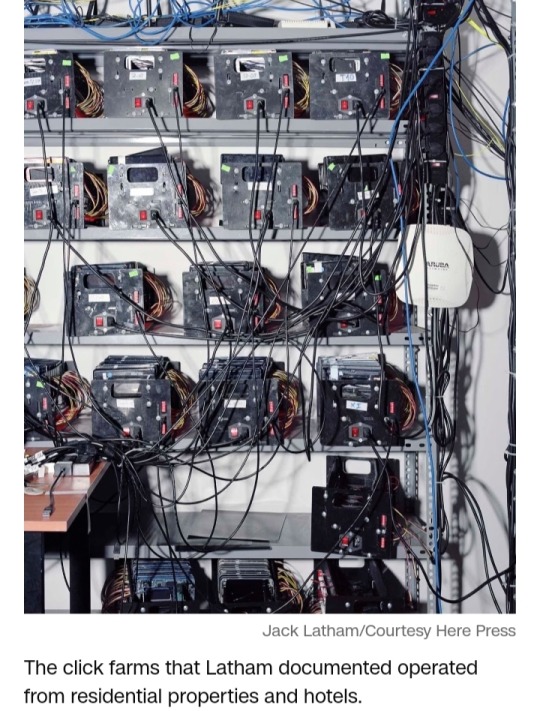
Latham said one of the click farms he visited was a family-run business, though the others appeared more like a tech companies.
Most workers were in their 20s and 30s, he added.
“They all looked like Silicon Valley startups,” he said. “There was a tremendous amount of hardware … whole walls of phones.”
Some of Latham’s photos depict — albeit anonymously — workers tasked with harvesting clicks.
In one image, a man is seen stationed amid a sea of gadgets in what appears to be a lonely and monotonous task.
“It only takes one person to control large amounts of phones,” Latham said. “One person can very quickly (do the work of) 10,000. It’s both solitary and crowded.”
At the farms Lathan visited, individuals were usually in charge of a particular social media platforms.
For instance, one “farmer” would be responsible for mass posting and commenting on Facebook accounts, or setting up YouTube platforms where they post and watch videos on loop.
The photographer added that TikTok is now the most popular platform at the click farms he visited.
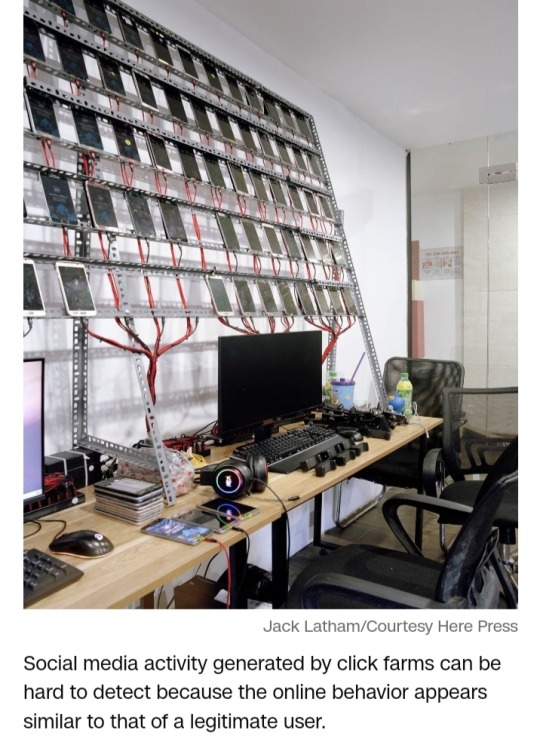
The click farmers Latham spoke to mostly advertised their services online for less than one cent per click, view or interaction.
And despite the fraudulent nature of their tasks, they seemed to treat it like just another job, the photographer said.
‘There was an understanding they were just providing a service,” he added. “There wasn’t a shadiness. What they’re offering is shortcuts.”
Deceptive perception
Across its 134 pages, “Beggar’s Honey” includes a collection of abstract photographs — some seductive, others contemplative — depicting videos that appeared on Latham’s TikTok feed.
He included them in the book to represent the kind of content he saw being boosted by click farms.
But many of his photos focus on the hardware used to manipulate social media —webs of wires, phones and computers.
“A lot of my work is about conspiracies,” Latham said. ” Trying to ‘document the machines used to spread disinformation’ is the tagline of the project. The bigger picture is often the thing we don’t see.”
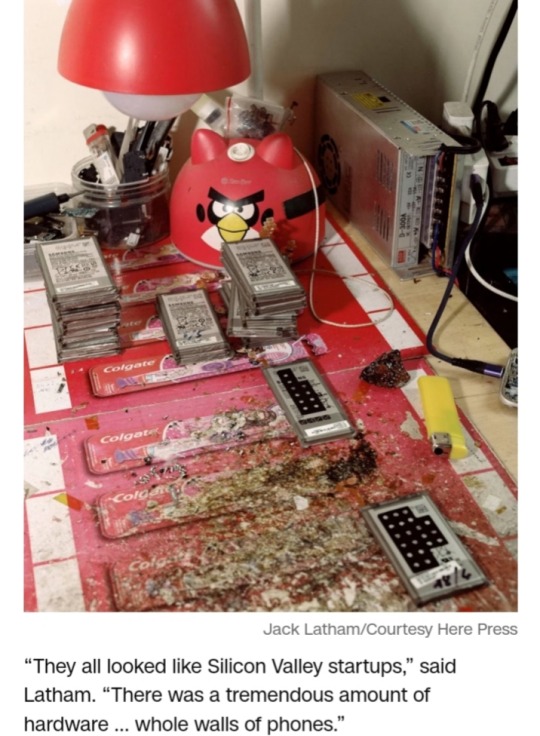
Click farms around the world are also used to amplify political messages and spread disinformation during elections.
In 2016, Cambodia’s then-prime minister Hun Sen was accused of buying Facebook friends and likes, which according to the BBC he denied, while shadowy operations in North Macedonia were found to have spread pro-Donald Trump posts and articles during that year’s US presidential election.
While researching, Latham said he found that algorithms — a topic of his previous book, “Latent Bloom” — often recommended videos that he said got increasingly “extreme” with each click.
“If you only digest a diet of that, it’s a matter of time you become diabetically conspiratorial,” he said.
“The spreading of disinformation is the worst thing. It happens in your pocket, not newspapers, and it’s terrifying that it’s tailored to your kind of neurosis.”
Hoping to raise awareness of the phenomenon and its dangers, Latham is planning to exhibit his own home version of a click farm — a small box with several phones attached to a computer interface — at the 2024 Images Vevey Festival in Switzerland.
He bought the gadget in Vietnam for the equivalent of about $1,000 and has occasionally experimented with it on his social media accounts.
On Instagram, Latham’s photos usually attract anywhere from a few dozen to couple hundred likes.
But when he deployed his personal click farm to announce his latest book, the post generated more than 6,600 likes.
The photographer wants people to realize that there’s more to what they see on social media — and that metrics aren’t a measurement of authenticity.
“When people are better equipped with knowledge of how things work, they can make more informed decisions,” he said.

“Beggar’s Honey,” co-published by Here Press and Images Vevey, is available now.
#Jack Latham#click farms#box farms#Hanoi#Vietnam#Beggar’s Honey#box farming#social media#algorithms#user perception#trolls#PR#marketing#advertising#likes#comments#shares#digital profiles#virtual gang masters#bots#spam#China Advertising Association#click farmers#mass post#disinformation#misinformation#fake news#metrics
11 notes
·
View notes
Photo

Success in life can be most accurately measured in terms of what you wanted to succeed at. -- Michael Lipsey
72 notes
·
View notes
Text
abuse of software metrics
When software projects judge themselves by the number of open issues, or how long issues remain open, there's a tendency to rush issues to closure and close issues that shouldn't be closed.
I'm seeing this phenomenon with the Assimp project. The project's GitHub repository publicizes metrics like "issue resolution" in days and the percentage of all issues that are open.
During the past month or so, I filed a slew of bug reports with Assimp, mostly related to the ".blend" file format. Recently, the project manager closed all those issues, saying that the .blend format was "deprecated", meaning the project no longer supports it.
But the documentation said (and still says) that ".blend" is supported.
Later that same day they started a discussion about deprecating the format. The causality is clear, and it looks to me like an effort to improve those metrics.
How do I feel about this? At first glance, the effort I put into those issues seems wasted, which is irritating and a bit sad. But if my work pushes the project to be honest about its limitations, perhaps that's best for everyone in the long run.
#software development#software engineering#metrics#software bugs#blender3d#self deprecation#open source
16 notes
·
View notes
Text






Peep show, 2007
#comedy#peep show#holiday#becky martin#andrew o'connor#jesse armstrong#sam bain#david mitchell#robert webb#katy brand#metrics#i can't with this fucking series
8 notes
·
View notes
Text
Predictive vs Prescriptive vs Descriptive Analytics Explained
Business analytics leveraging data patterns for strategic moves comes in three key approaches – descriptive identifying “what has occurred", predictive forecasting “what could occur” and prescriptive recommending “what should occur” to optimize decisions. We decode the science behind each for aspiring analytics professionals.
Descriptive analytics convert volumes of historical data into insightful summaries around metrics revealing business health, customer trends, operational efficiencies etc. using direct analysis, aggregation and mining techniques producing current reports.
Predictive analytics forecast unknown future probabilities applying statistical, econometric and machine learning models over existing data to minimize uncertainties and capture emerging behaviors early for mitigation actions. Risk models simulate scenarios balancing upside/downside tradeoffs.
Prescriptive analytics take guidance one step further by dynamically recommending best decision options factoring in key performance indicators for business objective improvements after predicting multiple futures using bell curve simulations. Optimization algorithms deliver preferred actions.
While foundational data comprehension and wrangling abilities fuel all models – pursuing analytics specializations focused on statistical, computational or operational excellence boosts career-readiness filling different priorities global employers seek!
Posted By:
Aditi Borade, 4th year Barch,
Ls Raheja School of architecture
Disclaimer: The perspectives shared in this blog are not intended to be prescriptive. They should act merely as viewpoints to aid overseas aspirants with helpful guidance. Readers are encouraged to conduct their own research before availing the services of a consultant.
#analytics#types#predictive#prescriptive#descriptive#PrescriptiveAnalytics#StrategicMoves#AnalyticsProfessionals#DataScience#HistoricalData#Metrics#BusinessHealth#CustomerTrends#OperationalEfficiencies#StatisticalModels#EconometricModels#MachineLearningModels#EnvoyOverseas#EthicalCounselling#EnvoyInternationalStudents#EnvoyCounselling
3 notes
·
View notes
Text
22 November 2023 Metrics
Previous Word Count: 68,305
New Words: 104
Total words for the first draft: 68,409
NaNo 2023 Cumulative Word Count: 22,902
What I Accomplished in the Narrative Today: Fifteen minutes on the text before I had to finish up house chores and drive to my sister’s house for Thanksgiving.
Fave line: “Maybe you can actually do something. Girls and guys who work the streets have been disappearing. And then body parts have been showing up. So far, only Ashley got named, Ashley Tang. Maybe she’s the only one with all her parts in the morgue.”
What Else I Accomplished Today: Today is a travel day. I got the house set up for being gone three days-ish, then drove for six hours and forty-five minutes with a few stops along the way. There was no more writing after I was able to stop.
What I'm looking forward to: Not being in the car.
What I'm not looking forward to: Having to drive again on Saturday.
2 notes
·
View notes
Text
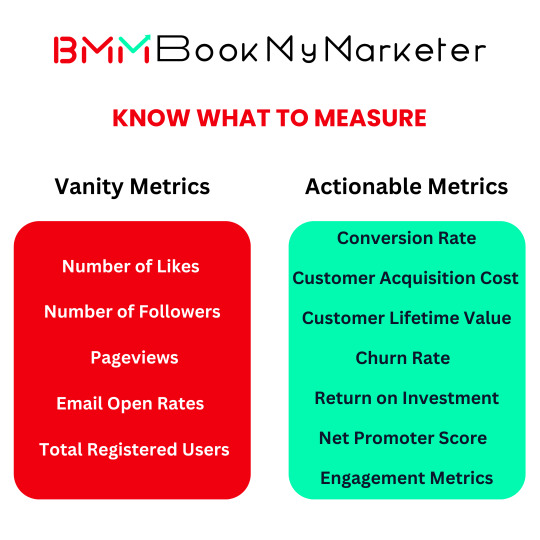
"Measure Smart: Ditch Vanity Metrics, Embrace Actionable Insights. 📊💡 #MetricsThatMatter"
4 notes
·
View notes
Quote
If medicine is business, and care is the commodity, actualized health impedes the profitability of morbidity.
Zisa Aziza
#Truths89#medicine#healthcare#deathcare#morbidity#profit#metrics#care looters#distrusting#self determination#self accountability#holistic health#intermentient#intermittentfasting#herbs#movement#NegressOfSaturn#ZisaAziza#conartist#medicalscammers
6 notes
·
View notes
Photo

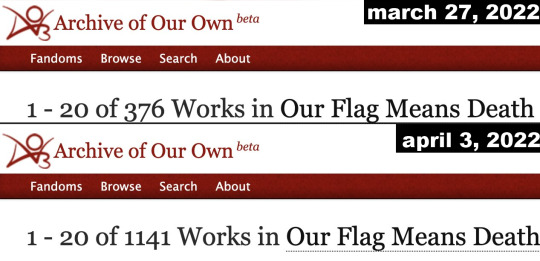
After the last 3 episodes of Our Flag Means Death, the fandom exploded. Cecelia Gray tracked this growth through https://archiveofourown.org. Listen to her discuss all this and more on this week's episode:
It’s All Fandom episode 26: Our Flag Means Death
25 notes
·
View notes
Text
A Real-World Example of Using Digital Marketing to Achieve Business Goals
New blog! Let's create a social media marketing and digital marketing plan for Tesla that will help reach its business goals.
Overcoming Tesla’s business challenges with digital marketing and social media campaigns.
by Kimberly Eugene, 05/21/2023
Tesla, hereafter referred to as my client for the sake of this example, continues to prove that it is a brand that traverses into foreign territory. Its aura is synonymous with that of rockets, autonomous cars, and futuristic intentions for artificial intelligence that could…

View On WordPress
#A Fresh Sip#Aishwarya Balaji#content marketing#CPA#CPC#CPM#digital marketing#Elon Musk#Kimberly Eugene#marketing#Metrics#PPC#PRTYNVRNDS LLC#ROE#ROI#sober curious#social media marketing#Tesla#Twitter
6 notes
·
View notes
Photo
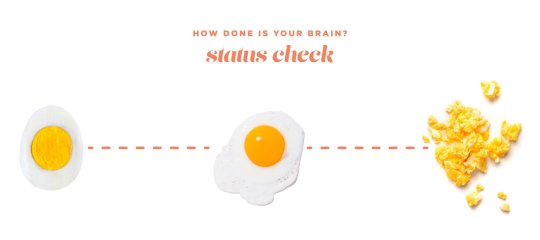
This scale is highly open to interpretation, but I see hard boiled as the good end and scrambled as the bad end.
#wellness check#graphic design#designblr#eggs#metrics#mental health#mental health awareness#food#graphic designer#chart#tumblr creator#creatr#jokes#vibe check#dumb
3 notes
·
View notes
Text
2022 recap + stat breakdown
Despite feeling, at times, like my writing was happening at the same speed and quality rate as pulling teeth through molasses, 2022 ended up being pretty productive. I've got three years on AO3 now to look back on:
What's interesting is seeing the crests and waves for engagement.
2022 Recap
15 works | 13 complete | 2 wip
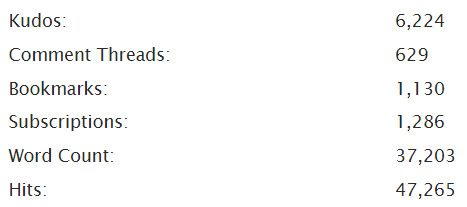
I thought I was really dragging my feet this year, but the year over year stat breakdown on my dashboard let me know that, no, that was 2021:
2021 Recap
4 works | all complete

2020 Recap
12 works | all complete

My 2022 word count is creeping up, I've got a couple pieces to finish in the next few weeks. Not sure I'll reach the 50k+ level from 2020 though.
Overall

Hits:Kudos 13% | Hits:Comments 1% | Hits:Bookmarks 2.6%
My kudos ratio is holding, and comments are on a slight upward trend. I've seen a number of posts going around Tumblr re: not treating creators like content factories/comments feed creativity, etc, and I'm wondering if some of the recent rise in comments comes from there. Or maybe people are just getting to know me as a writer.
Terrible Future Prediction
I've got the dark heart of a marketer and I can't help but wonder how sustainable we are. I'm not saying there's going to be a rise in AI fanfiction (just... why?), but I do question if the volume of autogen content (even if it's shitty content) is going to exacerbate people's rapidly declining patience for new material and updates.
5 notes
·
View notes